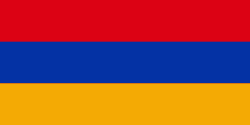Flag of Armenia
The national flag of Armenia, the Armenian Tricolour, consists of three horizontal bands of equal width, red on the top, blue in the middle, and apricot on the bottom. The Armenian Supreme Soviet adopted the current flag on 24 August 1990. On 15 June 2006, the Law on the National Flag of Armenia, governing its usage, was passed by the National Assembly of Armenia.
Throughout history, there have been many variations of the Armenian flag. In ancient times, Armenian dynasties were represented by different symbolic animals displayed on their flags. In the twentieth century, various Soviet flags represented the Armenian SSR.
The meanings of the colors are interpreted in many different ways. The red stands for the Armenian Highlands, the Armenian people's continued struggle for survival, maintenance of the Christian faith and Armenia's independence and freedom. Blue is for the Armenian peaceful skies. And orange represents the nation's talent and hard-work.
In 2012, the Armenian National Institute of Standards (SARM) issued specifications about the construction and colors on the national flag.:
The official definition of the colors, as stated in the Constitution of Armenia, is:
Throughout history, there have been many variations of the Armenian flag. In ancient times, Armenian dynasties were represented by different symbolic animals displayed on their flags. In the twentieth century, various Soviet flags represented the Armenian SSR.
The meanings of the colors are interpreted in many different ways. The red stands for the Armenian Highlands, the Armenian people's continued struggle for survival, maintenance of the Christian faith and Armenia's independence and freedom. Blue is for the Armenian peaceful skies. And orange represents the nation's talent and hard-work.
In 2012, the Armenian National Institute of Standards (SARM) issued specifications about the construction and colors on the national flag.:
The official definition of the colors, as stated in the Constitution of Armenia, is:
National flag
Country - Armenia
Warning: getimagesize(/Image/Map/MP174982.gif): failed to open stream: No such file or directory in /home/mapnlee7/public_html/MAPNALL/article.php on line 532
 |
 |
Armenia is a unitary, multi-party, democratic nation-state with an ancient cultural heritage. The first Armenian state of Urartu was established in 860 BC, and by the 6th century BC it was replaced by the Satrapy of Armenia. The Kingdom of Armenia reached its height under Tigranes the Great in the 1st century BC and in the year 301 became the first state in the world to adopt Christianity as its official religion. The ancient Armenian kingdom was split between the Byzantine and Sasanian Empires around the early 5th century. Under the Bagratuni dynasty, the Bagratid Kingdom of Armenia was restored in the 9th century. Declining due to the wars against the Byzantines, the kingdom fell in 1045 and Armenia was soon after invaded by the Seljuk Turks. An Armenian principality and later a kingdom Cilician Armenia was located on the coast of the Mediterranean Sea between the 11th and 14th centuries.
